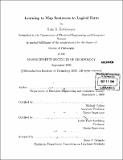| dc.contributor.advisor | Michael Collins and Leslie Pack Kaelbling. | en_US |
| dc.contributor.author | Zettlemoyer, Luke S. (Luke Sean), 1978- | en_US |
| dc.contributor.other | Massachusetts Institute of Technology. Dept. of Electrical Engineering and Computer Science. | en_US |
| dc.date.accessioned | 2010-04-28T17:14:37Z | |
| dc.date.available | 2010-04-28T17:14:37Z | |
| dc.date.copyright | 2009 | en_US |
| dc.date.issued | 2009 | en_US |
| dc.identifier.uri | http://hdl.handle.net/1721.1/54648 | |
| dc.description | Thesis (Ph. D.)--Massachusetts Institute of Technology, Dept. of Electrical Engineering and Computer Science, 2009. | en_US |
| dc.description | Cataloged from PDF version of thesis. | en_US |
| dc.description | Includes bibliographical references (p. 105-111). | en_US |
| dc.description.abstract | One of the classical goals of research in artificial intelligence is to construct systems that automatically recover the meaning of natural language text. Machine learning methods hold significant potential for addressing many of the challenges involved with these systems. This thesis presents new techniques for learning to map sentences to logical form - lambda-calculus representations of their meanings. We first describe an approach to the context-independent learning problem, where sentences are analyzed in isolation. We describe a learning algorithm that takes as input a training set of sentences labeled with expressions in the lambda calculus. The algorithm induces a Combinatory Categorial Grammar (CCG) for the problem, along with a log-linear model that represents a distribution over syntactic and semantic analyses conditioned on the input sentence. Next, we present an extension that addresses challenges that arise when learning to analyze spontaneous, unedited natural language input, as is commonly seen in natural language interface applications. A key idea is to introduce non-standard CCG combinators that relax certain parts of the grammar - for example allowing flexible word order, or insertion of lexical items - with learned costs. We also present a new, online algorithm for inducing a weighted CCG. Finally, we describe how to extend this learning approach to the context-dependent analysis setting, where the meaning of a sentence can depend on the context in which it appears. The training examples are sequences of sentences annotated with lambda-calculus meaning representations. | en_US |
| dc.description.abstract | (cont.) We develop an algorithm that maintains explicit, lambda-calculus representations of discourse entities and uses a context-dependent analysis pipeline to recover logical forms. The method uses a hidden-variable variant of the perception algorithm to learn a linear model used to select the best analysis. Experiments demonstrate that the learning techniques we develop induce accurate models for semantic analysis while requiring less data annotate effort than previous approaches. | en_US |
| dc.description.statementofresponsibility | by Luke S. Zettlemoyer. | en_US |
| dc.format.extent | 111 p. | en_US |
| dc.language.iso | eng | en_US |
| dc.publisher | Massachusetts Institute of Technology | en_US |
| dc.rights | M.I.T. theses are protected by
copyright. They may be viewed from this source for any purpose, but
reproduction or distribution in any format is prohibited without written
permission. See provided URL for inquiries about permission. | en_US |
| dc.rights.uri | http://dspace.mit.edu/handle/1721.1/7582 | en_US |
| dc.subject | Electrical Engineering and Computer Science. | en_US |
| dc.title | Learning to map sentences to logical form | en_US |
| dc.type | Thesis | en_US |
| dc.description.degree | Ph.D. | en_US |
| dc.contributor.department | Massachusetts Institute of Technology. Department of Electrical Engineering and Computer Science | |
| dc.identifier.oclc | 606590254 | en_US |
